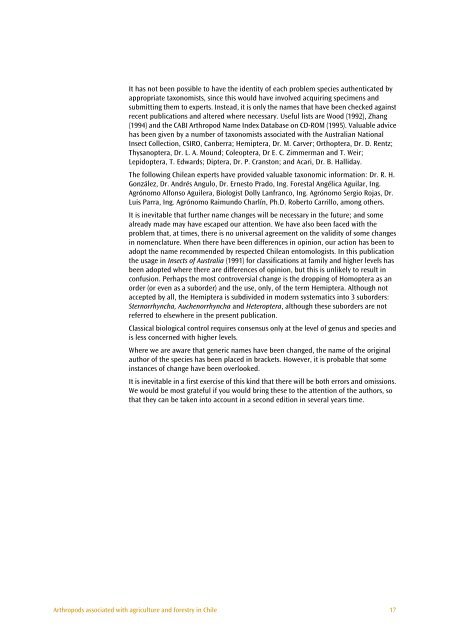The Distribution and Importance of Arthropods Associated with ...
The Distribution and Importance of Arthropods Associated with ...
The Distribution and Importance of Arthropods Associated with ...
You also want an ePaper? Increase the reach of your titles
YUMPU automatically turns print PDFs into web optimized ePapers that Google loves.
It has not been possible to have the identity <strong>of</strong> each problem species authenticated by<br />
appropriate taxonomists, since this would have involved acquiring specimens <strong>and</strong><br />
submitting them to experts. Instead, it is only the names that have been checked against<br />
recent publications <strong>and</strong> altered where necessary. Useful lists are Wood (1992), Zhang<br />
(1994) <strong>and</strong> the CABI Arthropod Name Index Database on CD-ROM (1995). Valuable advice<br />
has been given by a number <strong>of</strong> taxonomists associated <strong>with</strong> the Australian National<br />
Insect Collection, CSIRO, Canberra; Hemiptera, Dr. M. Carver; Orthoptera, Dr. D. Rentz;<br />
Thysanoptera, Dr. L. A. Mound; Coleoptera, Dr E. C. Zimmerman <strong>and</strong> T. Weir;<br />
Lepidoptera, T. Edwards; Diptera, Dr. P. Cranston; <strong>and</strong> Acari, Dr. B. Halliday.<br />
<strong>The</strong> following Chilean experts have provided valuable taxonomic information: Dr. R. H.<br />
González, Dr. Andrés Angulo, Dr. Ernesto Prado, Ing. Forestal Angélica Aguilar, Ing.<br />
Agrónomo Alfonso Aguilera, Biologist Dolly Lanfranco, Ing. Agrónomo Sergio Rojas, Dr.<br />
Luis Parra, Ing. Agrónomo Raimundo Charlín, Ph.D. Roberto Carrillo, among others.<br />
It is inevitable that further name changes will be necessary in the future; <strong>and</strong> some<br />
already made may have escaped our attention. We have also been faced <strong>with</strong> the<br />
problem that, at times, there is no universal agreement on the validity <strong>of</strong> some changes<br />
in nomenclature. When there have been differences in opinion, our action has been to<br />
adopt the name recommended by respected Chilean entomologists. In this publication<br />
the usage in Insects <strong>of</strong> Australia (1991) for classifications at family <strong>and</strong> higher levels has<br />
been adopted where there are differences <strong>of</strong> opinion, but this is unlikely to result in<br />
confusion. Perhaps the most controversial change is the dropping <strong>of</strong> Homoptera as an<br />
order (or even as a suborder) <strong>and</strong> the use, only, <strong>of</strong> the term Hemiptera. Although not<br />
accepted by all, the Hemiptera is subdivided in modern systematics into 3 suborders:<br />
Sternorrhyncha, Auchenorrhyncha <strong>and</strong> Heteroptera,<br />
although these suborders are not<br />
referred to elsewhere in the present publication.<br />
Classical biological control requires consensus only at the level <strong>of</strong> genus <strong>and</strong> species <strong>and</strong><br />
is less concerned <strong>with</strong> higher levels.<br />
Where we are aware that generic names have been changed, the name <strong>of</strong> the original<br />
author <strong>of</strong> the species has been placed in brackets. However, it is probable that some<br />
instances <strong>of</strong> change have been overlooked.<br />
It is inevitable in a first exercise <strong>of</strong> this kind that there will be both errors <strong>and</strong> omissions.<br />
We would be most grateful if you would bring these to the attention <strong>of</strong> the authors, so<br />
that they can be taken into account in a second edition in several years time.<br />
<strong>Arthropods</strong> associated <strong>with</strong> agriculture <strong>and</strong> forestry in Chile 17




